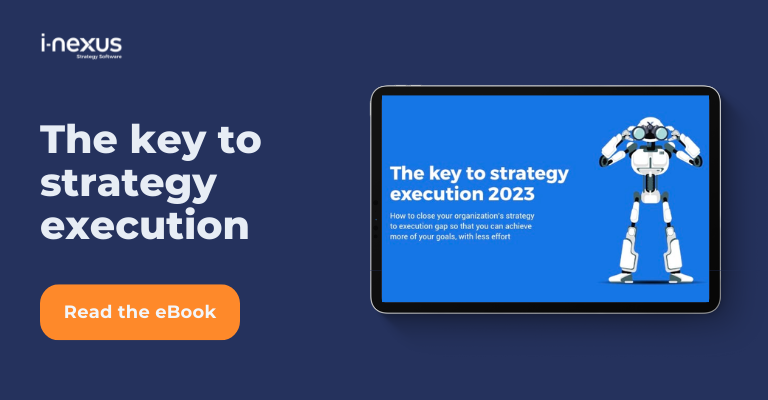You can’t realize your strategy if there’s a disconnect between strategy and strategic plans, with your long-term goals and functional daily priorities being misaligned. How can you get everyone on the same page? Read on as we share four ideas.
Written by: James Milsom, Head of Marketing
If a strategic plan, portfolio, program, or goal is disconnected from your business strategy, does it add value? That's the challenge facing organizations across the world - connecting strategy to strategic plans.
In the ideal world of management theory, it’s obvious how an organization can achieve its strategic goals.
Business strategies are set by the senior leadership team, and information flows smoothly down through each layer of management so that everyone in the company knows what to do and understands their role in delivering the overall vision.
In practice, it’s not that easy.
The top-level strategy is often defined at a high, corporate level, and the detailed work of mapping its objectives to practical goals is generally an exercise left for each business function to work out for itself.
Moreover, overall strategies are typically designed to be delivered over multiple years, while functional performance is planned, forecast, and measured on a quarterly or annual basis.
This inevitably leads to a dilemma over whether to prioritize short-term results or the long-term plan—and the long-term plan is usually the loser.
As Hamel and Prahalad put it:
“There seems to be, in many companies, an implicit assumption that the short term and long term abut each other, rather than being dovetailed together. But the long term doesn’t start at year five of the current strategic plan. It starts right now!”
Gary Hamel and C. K. Prahalad, “Competing for the Future” (1994)
So, what causes this disconnect, and how can we find ways to bridge the gap between business and functional strategies?
This blog addresses the differences between often well-thought-out business strategy and functional business strategies, and the ways in which you can help your organization create unity between the two, ensuring that every effort serves the corporate strategy.
1) Define strategies together
While there are many generic strategies and various strategies that can be adopted by an organization, often the issue isn't with the choice of strategy, but more so its execution.
Therefore we turn to internal issues.
Corporate strategies often fail because they don’t clearly define how they relate to functional and operational strategies.
This may be due to a lack of understanding on both sides.
Senior leaders may not know key details about the functional realities, while heads of functional areas may not be aware of the reasoning or motivations behind the top-level strategy.
That’s why it’s often a profitable exercise to involve functions in the development of the business strategy.

Bringing subject matter experts from HR, marketing, finance and other areas into the discussion improves engagement and gives functional leaders a sense of ownership.
At the same time, it gives managers more insight into how their strategy can and should be executed at the functional level, helping them ensure that short-term targets don’t conflict with longer-term goals.
How to manage this type of collaboration depends on the size and culture of your organization.
For smaller businesses, one-to-one collaborative sessions might be the most direct approach, while in larger firms, surveys might be a more productive approach.
Techniques such as catchball can also be a useful exercise for working through problems and gaining consensus between people at all levels of the organization.
2) Socialize the strategies
Involving representatives from functional areas in the definition of the corporate strategy will go some way towards closing the gap in understanding, but it’s not enough.
The next step is to ensure that the strategy is communicated throughout the organization. Doing so should ensure widespread understanding of the relationship between the strategic goals and their functional execution.
This is vital, because according to Kaplan and Norton, “less than 5 percent of the typical workforce understands their organization’s strategy”.
And if department heads, managers, and team members don’t know how or why their work contributes to the company’s overall objectives, they can easily become disconnected from the mission.
This is an area where technology can help.
With the right strategy execution systems in place, it’s easier to help teams connect the dots by communicating their responsibilities and setting concrete goals and milestones.
3) Track performance against the strategies and their plans
Strategy delivery information doesn’t just need to flow down from senior leaders to business functions - it also needs to flow back up from the functional level to the leadership team.
To ensure that strategic portfolios and their programs are being delivered effectively, leaders must be able to monitor the progress of each function and team towards the goals and milestones set for them.
Again, the right technology can make a difference here.
If teams are separately tracking their progress using documents, spreadsheets, and departmental project management systems, it’s almost impossible for leaders to get a timely and accurate overview of performance.
Instead, if everyone's work and KPIs are integrated into the system to log their activities and monitor their performance against their strategic objectives, you can get a clear answer to a simple question:
“will we achieve our goals?”.
4) Adapt your strategic plans at pace
Once you can track how performance at the functional level impacts the delivery of strategic objectives, you can make better decisions about what to focus on.
Most strategic programs, and indeed Hoshin Kanri with its improvement priorities, involve an element of experimentation and risk. Even if they are executed perfectly at a functional level, they may not deliver the expected benefits.
If that’s the case, you want to know as soon as possible, so that you can prioritize the most effective programs within the strategic portfolio, and shut down the ones that aren’t productive.
This requires a feedback loop that is much tighter than the traditional annual review of the strategy.
As conditions change, you want your functional teams to be able to provide a regular narrative of the issues they are facing.
With this capability, you can spot challenges quickly, reassess outdated assumptions, and pivot your strategy to deliver the best results possible, whatever the immediate circumstances.
Preparing to reconnect strategy and practice
Some common threads exist with reconnecting strategy and practice:
- Improve your communication
- Regularly review delivery
- Integration information systems
Adopting better communication techniques and regular strategic delivery reviews will offer a solid beginning for linking business and functional work.
However, building on this solid foundation will require a fresh take on your information systems - specifically integrating them to create a single source of strategic truth.
That is where joining your ERP and project management software, for example, to a Strategy Execution system will allow greater focus and alignment to be reached.
Getting to that stage is a journey, and your readiness to embrace such a system as i-nexus is dependent on your ability to realize the first two items of that list.
Only when you are confident in the first two items can you move towards truly connecting strategy and practice, and business to functional strategies.
Learn more about improving strategy delivery
Continue exploring how to improve your strategy delivery by visiting our strategy execution knowledge hub, or with any of the below:
- Key to Strategy Execution eBook: Read how companies like Danaher and HP have mastered Strategy Execution Management and what you can learn from them.
- What Does It Mean To Be Business Agile?: Take the leap into the future of strategic planning and execution with this fascinating insight.
- How AI and Machine-Assisted Learning Will Help Strategy Execution: As Artificial Intelligence becomes a mainstay in our lives, read how AI and machine-assisted learning will evolve to support your Strategy Execution.
About the author
James Milsom is Head of Marketing at i-nexus. James has wide-ranging experience in markets such as telecommunications, energy, education, and software.
As Head of Marketing, his drive is to raise awareness and understanding of the challenges facing enterprises in delivering strategic objectives and transformation amidst changing markets and the obstacles traditional tools and methods present leaders.
If you’d like to talk more about Strategy Execution, reach out to James on james.milsom@i-nexus.com or connect with him on LinkedIn for the latest insights.





